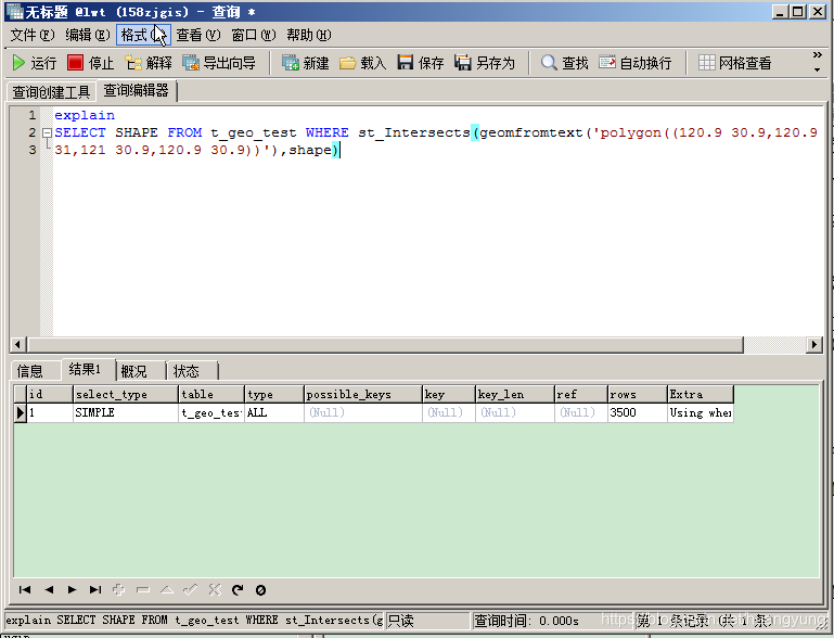MySQL空间扩展支持几何数据的存储,生成,分析,优化。
1、空间数据类型(存储)
MySQL支持以下数据类型:
Geometry:可以存储所有的几何类型
Point:简单点
LINESTRING:简单线
POLYGON:简单面
MULITIPOINT:多点
MULITILINESTRING:多线
MUILITIPOLYGON:多面
GEOMETRYCOLLECTION:任何几何集合
在创建表的时候可以根据需求选择合适的几何类型存储你的空间数据。
2、空间数据类型的生成
MySQ L支持WKB,WKT数据生成空间数据类型,提供如下函数:
GeomFromText(wtk [,srid) PointFromText LINESTRINGFROMTEXT …
GeomFromWKB(wtk [,srid) GeomFromWKB GeomFromWKB …
3、空间运算分析
MYSQL以函数的形式提供对空间运算的支持:
ST_Buffer ST_Contains ST_Distance ST_Intersects MBRIntersects …
4、优化
为了优化查询,MySQL提供空间索引支持,目前仅在MyISAM数据引擎下提供空间索引支持,要求几何字段非空
创建空间索引格式如下:
CREATE SPATIAL INDEX t_geo_test_sidx ON t_geo_test(SHAPE);
可以看到比普通索引多了一个关键字 Spatial,删除空间索引的语句与删除普通索引的语句是一样的。
5、测试
建表:
CREATE TABLE t_geo_test (
ID int(11) NOT NULL ,
SHAPE geometry NOT NULL ,
PRIMARY KEY (ID)
)
ENGINE=MyISAM
DEFAULT CHARACTER SET=utf8 COLLATE=utf8_general_ci
CHECKSUM=0
ROW_FORMAT=DYNAMIC
DELAY_KEY_WRITE=0
;
插入数据:
insert into t_geo_test select fid,geomfromtext(shape) from zjgis.g_bd_substation_p;
查询:

通过SQL解释可以看到TYPE:ALL KEY:NULL 代表全表扫描
建索引:
CREATE SPATIAL INDEX t_geo_test_sidx ON t_geo_test(SHAPE);

可以看到TYPE:range KEY:t_geo_tesx_sidx 表示使用了空间索引t_geo_tesx_sidx
在数据量比较大的时候,空间索引至关重要。
建索引前查询时间:

建索引后查询时间:

虽然数据不多(3500左右),查询耗时还是有所差距的。
6、附:MySQL空间相关函数一览表
The following table lists each spatial function and provides a short description of each one.
Name Description
1、Area() Return Polygon or MultiPolygon area
2、AsBinary(), AsWKB() Convert from internal geometry format to WKB
3、AsText(), AsWKT() Convert from internal geometry format to WKT
4、Buffer() Return geometry of points within given distance from geometry
5、Centroid() Return centroid as a point
6、Contains() Whether MBR of one geometry contains MBR of another
7、Crosses() Whether one geometry crosses another
8、Dimension() Dimension of geometry
9、Disjoint() Whether MBRs of two geometries are disjoint
10、EndPoint() End Point of LineString
11、Envelope() Return MBR of geometry
12、Equals() Whether MBRs of two geometries are equal
13、ExteriorRing() Return exterior ring of Polygon
14、GeomCollFromText(),
15、GeometryCollectionFromText()
16、Return geometry collection from WKT
17、GeomCollFromWKB(),
18、GeometryCollectionFromWKB()
19、Return geometry collection from WKB
20、GeometryCollection() Construct geometry collection from geometries
21、GeometryN() Return N-th geometry from geometry collection
22、GeometryType() Return name of geometry type
23、GeomFromText(),
24、GeometryFromText()
25、Return geometry from WKT
26、GeomFromWKB(),
27、GeometryFromWKB()
28、Return geometry from WKB
29、GLength() Return length of LineString
30、InteriorRingN() Return N-th interior ring of Polygon
31、Intersects() Whether MBRs of two geometries intersect
32、IsClosed() Whether a geometry is closed and simple
33、IsEmpty() Placeholder function
34、IsSimple() Whether a geometry is simple
35、LineFromText(),
36、LineStringFromText()
37、Construct LineString from WKT
38、LineFromWKB(),
39、LineStringFromWKB()
40、Construct LineString from WKB
41、LineString() Construct LineString from Point values
42、MBRContains() Whether MBR of one geometry contains MBR of another
43、MBRDisjoint() Whether MBRs of two geometries are disjoint
44、MBREqual() Whether MBRs of two geometries are equal
45、MBRIntersects() Whether MBRs of two geometries intersect
46、MBROverlaps() Whether MBRs of two geometries overlap
47、MBRTouches() Whether MBRs of two geometries touch
48、MBRWithin() Whether MBR of one geometry is within MBR of another
49、MLineFromText(),
50、MultiLineStringFromText()
51、Construct MultiLineString from WKT
52、MLineFromWKB(),
53、MultiLineStringFromWKB()
54、Construct MultiLineString from WKB
55、MPointFromText(),
56、MultiPointFromText()
57、Construct MultiPoint from WKT
58、MPointFromWKB(),
59、MultiPointFromWKB()
60、Construct MultiPoint from WKB
61、MPolyFromText(),
62、MultiPolygonFromText()
63、Construct MultiPolygon from WKT
64、MPolyFromWKB(),
65、MultiPolygonFromWKB()
66、Construct MultiPolygon from WKB
67、MultiLineString() Contruct MultiLineString from LineString values
68、MultiPoint() Construct MultiPoint from Point values
69、MultiPolygon() Construct MultiPolygon from Polygon values
70、NumGeometries() Return number of geometries in geometry collection
71、NumInteriorRings() Return number of interior rings in Polygon
72、NumPoints() Return number of points in LineString
73、Overlaps() Whether MBRs of two geometries overlap
74、Point() Construct Point from coordinates
75、PointFromText() Construct Point from WKT
76、PointFromWKB() Construct Point from WKB
77、PointN() Return N-th point from LineString
78、PolyFromText(),
79、PolygonFromText()
80、Construct Polygon from WKT
81、PolyFromWKB(), PolygonFromWKB() Construct Polygon from WKB
82、Polygon() Construct Polygon from LineString arguments
83、SRID() Return spatial reference system ID for geometry
84、ST_Area() Return Polygon or MultiPolygon area
85、ST_AsBinary(), ST_AsWKB() Convert from internal geometry format to WKB
86、ST_AsText(), ST_AsWKT() Convert from internal geometry format to WKT
87、ST_Buffer() Return geometry of points within given distance from geometry
88、ST_Centroid() Return centroid as a point
89、ST_Contains() Whether one geometry contains another
90、ST_Crosses() Whether one geometry crosses another
91、ST_Difference() Return point set difference of two geometries
92、ST_Dimension() Dimension of geometry
93、ST_Disjoint() Whether one geometry is disjoint from another
94、ST_Distance() The distance of one geometry from another
95、ST_EndPoint() End Point of LineString
96、ST_Envelope() Return MBR of geometry
97、ST_Equals() Whether one geometry is equal to another
98、ST_ExteriorRing() Return exterior ring of Polygon
99、ST_GeomCollFromText(),
100、ST_GeometryCollectionFromText(),
101、ST_GeomCollFromTxt()
102、Return geometry collection from WKT
103、ST_GeomCollFromWKB(),
104、ST_GeometryCollectionFromWKB()
105、Return geometry collection from WKB
106、ST_GeometryN() Return N-th geometry from geometry collection
107、ST_GeometryType() Return name of geometry type
108、ST_GeomFromText(),
109、ST_GeometryFromText()
110、Return geometry from WKT
111、ST_GeomFromWKB(),
112、ST_GeometryFromWKB()
113、Return geometry from WKB
114、ST_InteriorRingN() Return N-th interior ring of Polygon
115、ST_Intersection() Return point set intersection of two geometries
116、ST_Intersects() Whether one geometry intersects another
117、ST_IsClosed() Whether a geometry is closed and simple
118、ST_IsEmpty() Placeholder function
119、ST_IsSimple() Whether a geometry is simple
120、ST_LineFromText(),
121、ST_LineStringFromText()
122、Construct LineString from WKT
123、ST_LineFromWKB(),
124、ST_LineStringFromWKB()
125、Construct LineString from WKB
126、ST_NumGeometries() Return number of geometries in geometry collection
127、ST_NumInteriorRing(),
128、ST_NumInteriorRings()
129、Return number of interior rings in Polygon
130、ST_NumPoints() Return number of points in LineString
131、ST_Overlaps() Whether one geometry overlaps another
132、ST_PointFromText() Construct Point from WKT
133、ST_PointFromWKB() Construct Point from WKB
134、ST_PointN() Return N-th point from LineString
135、ST_PolyFromText(),
136、ST_PolygonFromText()
137、Construct Polygon from WKT
138、ST_PolyFromWKB(),
139、ST_PolygonFromWKB()
140、Construct Polygon from WKB
141、ST_SRID() Return spatial reference system ID for geometry
142、ST_StartPoint() Start Point of LineString
143、ST_SymDifference() Return point set symmetric difference of two geometries
144、ST_Touches() Whether one geometry touches another
145、ST_Union() Return point set union of two geometries
146、ST_Within() Whether one geometry is within another
147、ST_X() Return X coordinate of Point
148、ST_Y() Return Y coordinate of Point
149、StartPoint() Start Point of LineString
150、Touches() Whether one geometry touches another
151、Within() Whether MBR of one geometry is within MBR of another
152、X() Return X coordinate of Point
153、Y() Return Y coordinate of Point